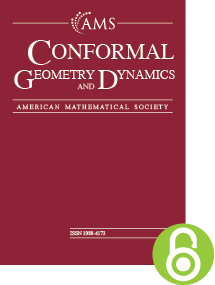Totally ramified rational maps
HTML articles powered by AMS MathViewer
- by Weiwei Cui and Jun Hu
- Conform. Geom. Dyn. 26 (2022), 208-234
- DOI: https://doi.org/10.1090/ecgd/377
- Published electronically: December 6, 2022
- PDF | Request permission
Abstract:
Totally ramified rational maps and regularly ramified rational maps are defined and studied in this paper. We first give a complete classification of regularly ramified rational maps and show that our definition of a regularly ramified rational map is equivalent to a much stronger definition of a map of this kind given by Milnor [Dynamics in one complex variable, Princeton University Press, Princeton, NJ, 2006]. Then we show that (1) any totally ramified rational map of degree $d\leq 6$ must be regularly ramified; (2) for any integer $d>6$, there exists a totally ramified rational map of degree $d$ which is not regularly ramified. Furthermore, we count totally ramified rational maps up to degree $10$. Finally, we present explicit formulas for all totally but not regularly ramified rational maps of degree $7$ or $8$, up to pre- and post-composition by Möbius transformations.References
- Itai Benjamini, Sergei Merenkov, and Oded Schramm, A negative answer to Nevanlinna’s type question and a parabolic surface with a lot of negative curvature, Proc. Amer. Math. Soc. 132 (2004), no. 3, 641–647. MR 2019938, DOI 10.1090/S0002-9939-03-07147-8
- Weiwei Cui, Entire functions arising from trees, Sci. China Math. 64 (2021), no. 10, 2231–2248. MR 4316137, DOI 10.1007/s11425-019-1644-0
- Reinhard Diestel, Graph theory, 5th ed., Graduate Texts in Mathematics, vol. 173, Springer, Berlin, 2017. MR 3644391, DOI 10.1007/978-3-662-53622-3
- Hershel M. Farkas and Irwin Kra, Riemann surfaces, Graduate Texts in Mathematics, vol. 71, Springer-Verlag, New York-Berlin, 1980. MR 583745, DOI 10.1007/978-1-4684-9930-8
- Ernesto Girondo and Gabino González-Diez, Introduction to compact Riemann surfaces and dessins d’enfants, London Mathematical Society Student Texts, vol. 79, Cambridge University Press, Cambridge, 2012. MR 2895884
- Anatoly A. Goldberg and Iossif V. Ostrovskii, Value distribution of meromorphic functions, Translations of Mathematical Monographs, vol. 236, American Mathematical Society, Providence, RI, 2008. Translated from the 1970 Russian original by Mikhail Ostrovskii; With an appendix by Alexandre Eremenko and James K. Langley. MR 2435270, DOI 10.1090/mmono/236
- Jun Hu, Francisco G. Jimenez, and Oleg Muzician, Rational maps with half symmetries, Julia sets, and multibrot sets in parameter planes, Conformal dynamics and hyperbolic geometry, Contemp. Math., vol. 573, Amer. Math. Soc., Providence, RI, 2012, pp. 119–146. MR 2964076, DOI 10.1090/conm/573/11393
- Jun Hu, Oleg Muzician, and Yingqing Xiao, Dynamics of regularly ramified rational maps: I. Julia sets of maps in one-parameter families, Discrete Contin. Dyn. Syst. 38 (2018), no. 7, 3189–3221. MR 3809081, DOI 10.3934/dcds.2018139
- Jun Hu and Yingqing Xiao, No Herman rings for regularly ramified rational maps, Proc. Amer. Math. Soc. 147 (2019), no. 4, 1587–1596. MR 3910423, DOI 10.1090/proc/14347
- Gareth A. Jones and Jürgen Wolfart, Dessins d’enfants on Riemann surfaces, Springer Monographs in Mathematics, Springer, Cham, 2016. MR 3467692, DOI 10.1007/978-3-319-24711-3
- John Milnor, Dynamics in one complex variable, 3rd ed., Annals of Mathematics Studies, vol. 160, Princeton University Press, Princeton, NJ, 2006. MR 2193309
- Rolf Nevanlinna, Analytic functions, Die Grundlehren der mathematischen Wissenschaften, Band 162, Springer-Verlag, New York-Berlin, 1970. Translated from the second German edition by Phillip Emig. MR 0279280, DOI 10.1007/978-3-642-85590-0
- S. Stoïlow, Leçons sur les principes topologiques de la théorie des fonctions analytiques. Deuxième édition, augmentée de notes sur les fonctions analytiques et leurs surfaces de Riemann, Gauthier-Villars, Paris, 1956 (French). MR 0082545
Bibliographic Information
- Weiwei Cui
- Affiliation: Shanghai Center for Mathematical Sciences, Fudan University, 2005 Songhu Road, Shanghai 200438, People’s Republic of China; and Centre for Mathematical Sciences, Lund University, Box 118, 22 100 Lund, Sweden
- MR Author ID: 1014684
- ORCID: 0000-0003-2505-4710
- Email: cuiweiwei@fudan.edu.cn, weiwei.cui@math.lth.se
- Jun Hu
- Affiliation: Department of Mathematics, Brooklyn College of CUNY, Brooklyn, New York 11210; Ph.D. Program in Mathematics, Graduate Center of CUNY, 365 Fifth Avenue, New York, New York 10016; and NYU-ECNU Institute of Mathematical Sciences at NYU Shanghai, 3663 Zhongshan Road North, Shanghai 200062, People’s Republic of China
- MR Author ID: 617732
- ORCID: 0000-0003-4338-2048
- Email: junhu@brooklyn.cuny.edu, jhu1@gc.cuny.edu
- Received by editor(s): December 30, 2021
- Received by editor(s) in revised form: August 28, 2022
- Published electronically: December 6, 2022
- Additional Notes: The work of the first author was partially supported by China Postdoctoral Science Foundation (No. 2019M651329). The work of the second author was supported by a CUNY research fellowship leave and a visiting professorship at NYUShanghai in Spring 2019.
The second author is the corresponding author. - © Copyright 2022 American Mathematical Society
- Journal: Conform. Geom. Dyn. 26 (2022), 208-234
- MSC (2020): Primary 37F20; Secondary 37F10
- DOI: https://doi.org/10.1090/ecgd/377
- MathSciNet review: 4518758


